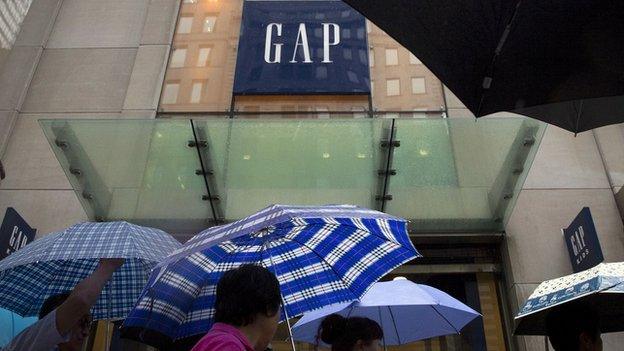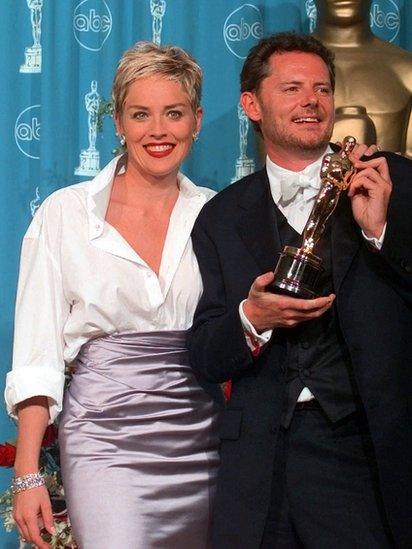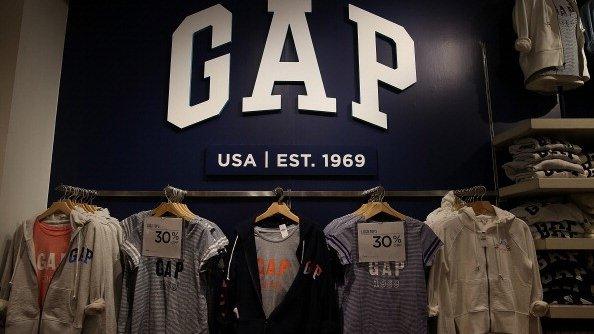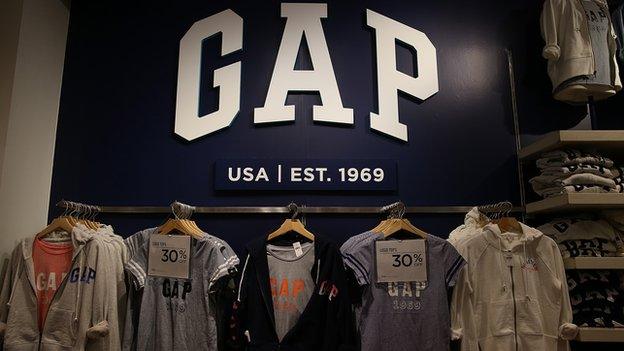Why Gap is in a tight squeeze
- Published

Rivals such as H&M and Zara have eaten into Gap's market share
In 1997, hip-hop artist LL Cool J starred in a 30-second Gap advert. It was during a particularly rosy era for the brand, whose sales by 2002 would more than triple to $13.8bn (£8.8bn) annually.
"Jeans popping in every mall and town and city," LL Cool J rapped in the TV spot, referencing the retailer's hugely popular denim offerings.
At the end, he closed with: "How easy is this? Fall into the Gap." But easy street has been hard for Gap to find recently.
Management missteps, a strong US dollar and lacklustre designs have hurt the once-dominant retailer, as has competition from fast-fashion brands.
Rivals such as H&M and Forever 21 offer a wider array of styles at lower prices.
Gap shops' July sales numbers reflect these challenges, with same-shop sales falling 7%.
Comparable sales for Banana Republic, a sister brand in Gap Inc's portfolio, fell 10% in the same period.
Old Navy, the most affordable and currently most successful Gap Inc brand, showed 3% growth.
Gap frenzy
"None of us are happy with the performance now," Gap chief executive Art Peck told shareholders at the company's annual investor meeting in June, a day after announcing about 175 Gap specialty shops in North America would close, most of them in the next fiscal year.
About 250 corporate jobs, external are also on the chopping block.
"I hate closing stores," Mr Peck said at the investor meeting, external, but called the downsizing "overdue" and "the right thing to do".
This sober news would have been unthinkable during the 1990s, when the brand was so popular Sharon Stone wore a simple Gap shirt with a designer skirt to the Oscars - twice.
At that time, I was growing up a state away from the company's California HQ and experienced the Gap frenzy firsthand.
In my eight-to-10-year-old mind, there was no better clothes shop, and most of my friends agreed.

Generation Gap
The first Gap shop opened in San Francisco in 1969
The company has grown into a multinational company with more than 150,000 employees
The chain has frequently used celebrities in its adverts including Madonna, Sarah Jessica Parker, Lauren Hutton and rapper LL Cool J
In October 2010, the company attempted to refresh its brand, but the new logo caused a public outcry and was dropped after a week

What I considered the best parts of my mid-to-late-90s wardrobe were from Gap; green velvet dungarees, purple jelly sandals and a maroon fleece pullover I wore until the fabric pilled.
Though Gap's earlier success was built on simple staples such as khakis and T-shirts, today's customers are more likely to want to stand out.

Sharon Stone in a Gap shirt at the 1998 Academy Awards, with director Mike van Diem
"Uniformity is no longer cool," said Simeon Siegel, a senior retail analyst at Nomura Securities. "The trick now is convincing your customer that they're getting something unique."
Compelling products
Consumers also have more demands on their dollar than buyers past. Besides fast fashion, accessories, online retailers and so-called "athleisure, external" wear have all taken money and attention away from iconic American mall-based brands.
It also doesn't help that Gap has grappled with its own aesthetic in recent years, struggling to rapidly and consistently deliver styles consumers want.
Gap spokeswoman, Kari Shellhorn told the BBC "Of top priority is delivering more consistent and compelling product collections."
Dana Telsey, the chief research officer at Telsey Advisory Group, said Gap's products needed work.
"Whether it's colour or print or it's pattern, the Gap brand hasn't been kept up to date," Ms Telsey said.

Retail analysts say uniformity is no longer seen as trendy in the clothing market
This was evident on a recent weeknight trip to a Gap shop in Herald Square, a Manhattan shopping hub.
Once inside, I was met with a display of the brand's signature solid coloured T-shirts and tops. They appeared unchanged from the Gap inventory I remember seeing as a child. When I visited, the shop had few customers.
Of those, I noticed that most of them were older than the 25- to 35-year-old target customer that Gap global president Jeff Kirwan described at the shareholder meeting in June.
The biggest crowd in sight were the eight women combing intently through racks of the sale section, stuffed with inventory. I asked my former flatmate, a Gap devotee, about this.
"I can't even remember the last time I bought anything full price at Gap," she said. "Probably never."
'No excuses moment'
Dana Telsey, of the Telsey Advisory Group, said she had noticed the abundant markdowns at Gap in her regular shop visits.
"Until they have their product right, I think we'll continue to see them have promotions," Ms Telsey said.
Next, for the sake of comparison, I visited the flagship H&M across the street, which opened in May.
A bass-heavy soundtrack and dancing security guard greeted me.
The shop was teeming with brightly patterned clothing and young people who seemed eager to buy. Upstairs, the queue to the dressing room was so long that some customers were turning away to avoid the wait.
The contrast highlights how urgently Gap will need to adjust course in order to compete, external.
Gap executives have told investors not to expect their turnaround plan to take hold until after the holidays.
As Mr Peck said earlier this year, spring 2016 will be "a no-excuses moment".
- Published15 June 2015

- Published9 October 2014

- Published22 August 2014
